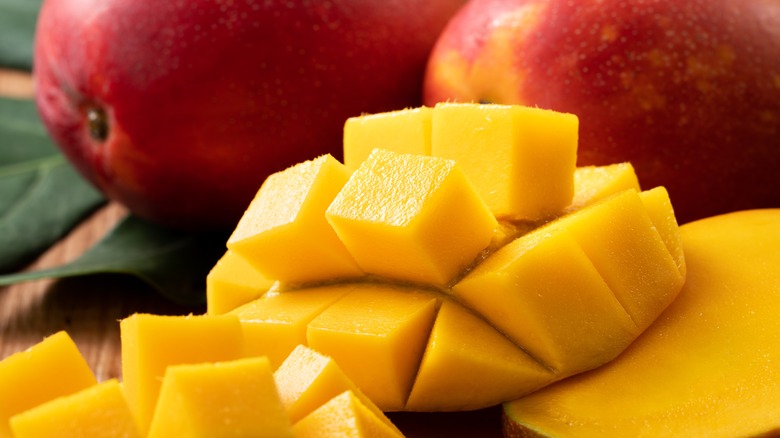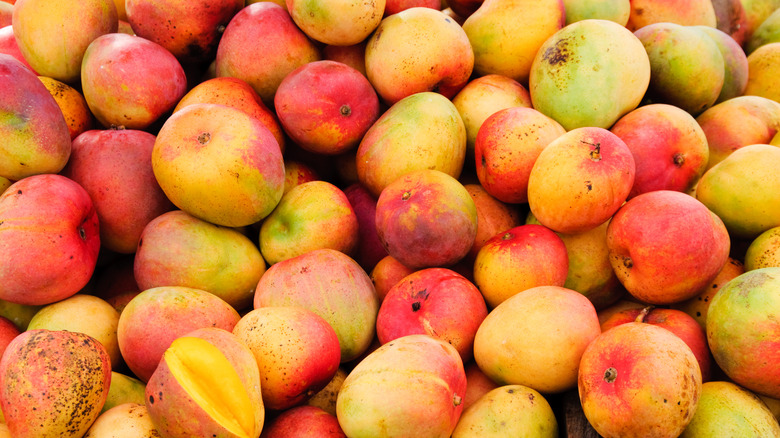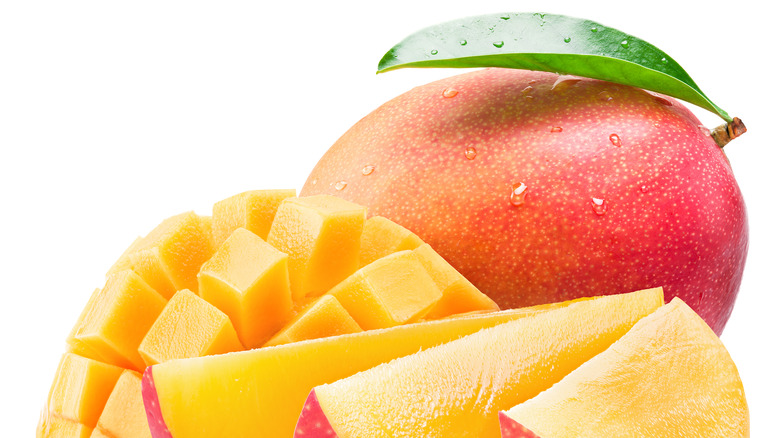3 Easy Ways To Tell If A Mango Is Ripe
A ripe, sweet mango makes a delicious addition to your meal, whether you puree it to make gummy candy, or eat it fresh in a fruit salad. But this tasty fruit can be bitter and hard if you eat it before it is ripe (and much harder to cut and enjoy as well). But wait too long, and it turns soft and slimy. Fortunately, there are telltale signs you can look for to determine if your mango is just right and ready to eat.
If you're at the grocery store perusing whole mangoes, you can rely on your senses of touch, sight, and smell to determine which ones are ripe — be sure to follow grocery store tips and tricks for the best produce selection. If you get an unripe mango, you can let it ripen at home, and even speed the process along with the paper bag method, similar to ripening an avocado. Mango flavor ranges from tart to super sweet, depending on how ripe the fruit is.
How a ripe mango feels
Look at and feel the skin of the mango. If it has very subtle wrinkles, it is ripe and ready to eat. A medium-ripe mango will be smoother, but not taut. The skin of an unripe mango is stretched and smooth, with noticeably less give. If the skin is too wrinkly and coarse, the mango might be overripe. If you are looking at pre-cut mango, look for fruit that has a firm flesh rather than a slimy one.
You can also give the mango a gentle squeeze to feel the inside. A ripe mango has a little bit of give, but does not stay indented when pressed. A medium-ripe mango is firm, but not hard like a rock. An unripe mango is much harder, and doesn't have any give at all. If you press the mango and can feel the skin separate from the flesh underneath, it is probably too ripe. If you get an unripe mango and want to ripen it at home, just put it in a brown paper bag for a day. Mangoes release ethylene gas, which helps them ripen faster when kept in a confined space, such as in a paper bag.
How a ripe mango looks
You may be tempted to look for the richest color when choosing a mango. But color is a poor indicator of the mango's ripeness or other qualities because different varieties of mangoes are naturally different colors. Some mangoes are a combination of green, red, and yellow. Other varieties are all yellow, while others have significant sections of orange skin. Some mango varieties are even all green. Even with a certain type, there can be variation in the amount of red, orange, yellow, or green on the skin of equally ripe fruits. Unlike avocados, which turn a deeper green color as they ripen, mangoes can be everything from green to red and still be ripe.
You can look at the skin's texture to get an idea of ripeness, however. A slightly wrinkled mango skin is an indication of a riper fruit. A smooth or taut skin means it is less ripe. An extremely wrinkled skin or a misshapen fruit likely means the mango is overripe. These visual clues can be helpful, especially when you pair them with other indicators like touch or smell. But the look of a mango is one of the least reliable ways to tell how ripe it is, especially if you are comparing its color to that of other mangoes nearby.
How a ripe mango smells
Scent is one of the best indicators of mango ripeness. As a mango ripens, the sweet smell of the fruit becomes stronger. Unripe mango tends to be tart and firm, so the smell will not be as noticeable, or even present at all. While unripe mangoes can still be delicious, don't expect them to be as sweet. sweetness you might expect. Instead, try to find a mango with a noticeable aroma.
To check the mango's smell, sniff around the stem. If it has a fruity aroma near the stem, the mango is ripe. No aroma means that it still needs some time to ripen if you want to enjoy really sweet fruit. If the fruit has a strong sweet smell all over, it will be very ripe and juicy. Some people prefer their mangoes this way, but make sure to eat them within a day or two to avoid them becoming overripe. The smell test isn't the best method to rely on when it comes to food safety — however, it can be a good indication of the ripeness level of a mango.



